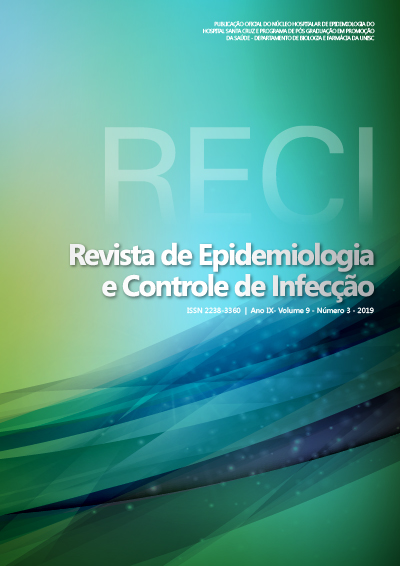Profile, symptoms and treatment performed in newborns diagnosed with sepsis
DOI:
https://doi.org/10.17058/reci.v9i3.12752Keywords:
Health Profile. Sepsis. Neonatal Sepsis. Infant, Newborn. Nursing.Abstract
Background and Objectives: Neonatal sepsis represents one of the main causes of morbidity and mortality in newborns. The aim of the present study was to know the profile, signs, symptoms and treatment performed in newborns diagnosed with sepsis, according to the final clinical condition (cure or death). Methods: retrospective, quantitative study. Data were collected from physical medical records of a Neonatal Intensive Care Unit (NICU) of a University Hospital (n=62). The newborns were divided into two groups: those who survived and those who died. Then, they were compared according to demographic and life characteristics of the newborn; signs and symptoms; identification of microorganisms and use of medicines. Data were analyzed by Fisher’s Exact test. (p≤0,05) and complied with the ethical guidelines (nº 2.133.726). Results: Of the newborns diagnosed with sepsis, 82% survived, of which those aged more than 30 weeks who remained in the NICU for more than eight days prevailed significantly (p<0.05). The newborns who died were aged up to 30 weeks and remained in the NICU for up to one week. Among the signs and symptoms, only hypotension was statistically significant for the outcome of death (p<0.007). The most prevalent microorganisms were coagulase negative Staphylococcus (p>0.05). For treatment, 60% used a combination of three or more antibiotics, mainly Gentamicin, Ampicillin, Oxacillin and Amikacin. Conclusion: the findings reinforce the knowledge about the profile of newborns with sepsis and the importance of investing in cross-sectional interventions during prenatal, postpartum and neonatal periods, in order to reduce neonatal infections and their consequences. Keywords: Health Profile. Sepsis. Neonatal Sepsis. Infant, Newborn. Nursing.Downloads
Downloads
Published
How to Cite
Issue
Section
License
The author must state that the paper is original (has not been published previously), not infringing any copyright or other ownership right involving third parties. Once the paper is submitted, the Journal reserves the right to make normative changes, such as spelling and grammar, in order to maintain the language standard, but respecting the author’s style. The published papers become ownership of RECI, considering that all the opinions expressed by the authors are their responsibility. Because we are an open access journal, we allow free use of articles in educational and scientific applications provided the source is cited under the Creative Commons CC-BY license.


